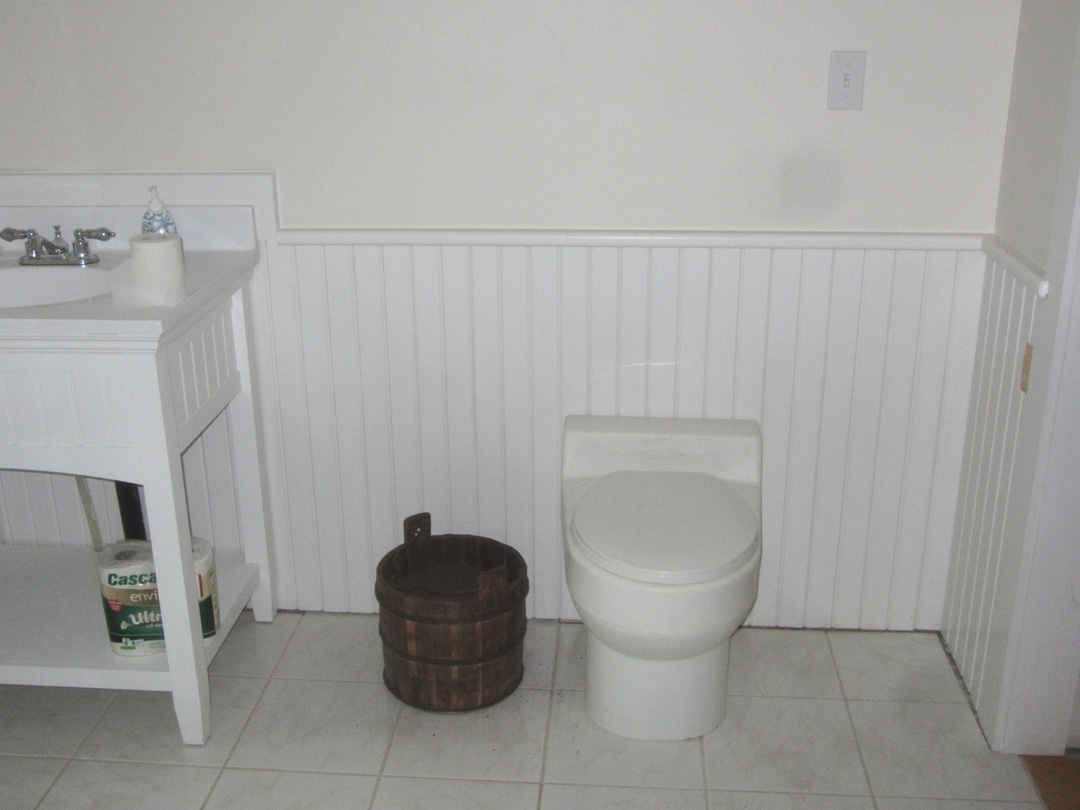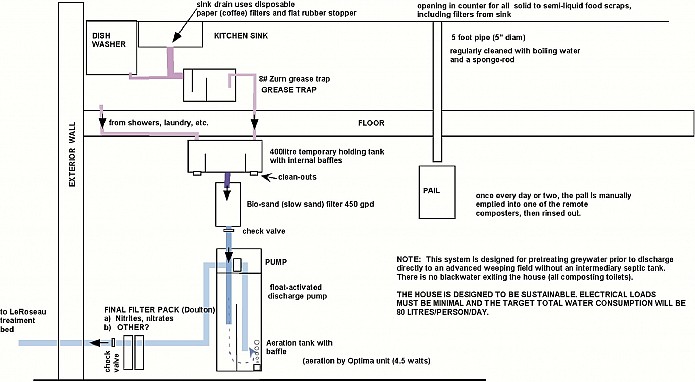The treating of household waste is of critical importance, particularly so given the sensitive location of the site near the shoreline of a lake. Lake Memphremagog has seen an acceleration of eutrophication in the last decade due to the buildup of phosphate and nitrate nutrient levels in the lake. A portion of the problem most certainly lies with inappropriate and ineffective residential waste treatment on properties that are proximal to the shoreline or its tributaries.
Blackwater Treatment. All three toilets are composting toilets. As such no blackwater directly exits the house. Once a year mature compost will be distributed with care to garden sites on the property (but none within 30m of the shoreline). Compost from human feces will have high nitrate values, but minimal phosphate.
Greywater treatment. Solarhurst is installing a comprehensive greywater treatment system, that should result in a near-potable effluent. This system is diagramed below and consists of the following elements.
1. Reduction in use of water in general and the employment of zero-phosphate ecofriendly cleaners and detergents.
2. Primary filtration of solid food particles from kitchen sinks by use of biodegradable (compostable) paper filters.
3. Grease trap under kitchen sinks
4. Holding/settling tank
5. Biosand slow filter (primary purification system, designed to produce potable water)
6. Aeration tank and pump (maintain aerobic activity while effluent awaits discharge)
7. Nitrate filters (removal of nitrates to prevent these nutrients ending up in lake).
We anticipate that waters leaving the house will have the following levels (or better)
Total coliform <75 cfu/100ml
Fecal coliform <1
E. coli <1
We will lab-test the quality of the effluent on a twice yearly basis
We did consider full greywater recycling but as water is in relatively plentiful supply, (but energy isn’t) we chose not to pursue this avenue. Credible recycling to potable levels would require UV or ozone systems, and represent relatively complex energy consuming technology.

Antiquated code and a bureaucracy with limited vision has dictated that we install both a septic tank and an advanced leach field. Given the effluent from the house, neither system will serve any meaningful function. Ironically the lack of biomass in the septic tank (and hence lack of heat generating microbial activity) means that the septic tank actually has a greater chance of freezing and cracking. We have insulated the tank to hopefully prevent such an event! The leach field is one designed by DBO Expert (Enviroseptic) and was chosen for its small footprint and the fact that it requires no energy input (other systems require pumps and/or aeration systems). Still the leach field works because nutrients from the effluent feed and encourage communities of microorganisms (hosted in the case of Enviroseptic by special membranes) that in turn effectively remove harmful pathogens. At Solarhurst the effluent reaching the leach field will contain neither pathogens nor nutrients.
Non-organic waste. Our household will endeavor to truly live up to the motto, Reduce, Reuse, Recycle, then Review. Organic wastes will all be composted. We will attempt to buy in bulk to reduce packaging (note: storage space in walk-in pantry). We will have special chutes in the kitchen to send cans, bottles etc downstairs to a special recycling centre to be set up in the basement.

